
In this article, we talk about text to speech for customer service automation and how it helps businesses serve customers better. From basic voice menus to smart AI assistants, we cover the tools that make customer support faster and friendlier.
Think about calling a company today. Instead of waiting forever on the phone, smart voice tools help you right away. That’s what text to speech for customer service automation is all about. Companies use these tools to help customers faster and better.
Listen to the Podcast: How Text to Speech is Transforming Customer Service Automation
With AI and smart voice systems, businesses can now give quick, personal help to every customer. This makes people happy to use their services again and again.
We’ll show you how these voice tools can make your customer service better, explain how they work, and share the latest ways to use them.
Key Takeaways
- Discover how text to speech for customer service can streamline support operations and enhance customer satisfaction
- Explore the key components and evolving landscape of speech technology in the customer service sector
- Understand the benefits of integrating voice response systems and interactive voice response (IVR) solutions in your customer service strategy
- Learn about the personalization capabilities, multi-language support, and voice brand identity creation offered by text to speech technology
- Discover the role of AI and machine learning in powering adaptive voice response systems for enhanced customer communication
Understanding Text to Speech Technology in Customer Service
Text-to-speech (TTS) is now big in customer service. It makes old IVR systems sound more natural and personal. Natural language processing (NLP) lets computers read text out loud, like a human.
How Natural Language Processing Works
Natural language processing (NLP) is key to TTS. It helps computers understand and make human language. NLP lets TTS systems get the meaning of text, making speech sound real.
This tech is behind conversational AI in call centers. It makes self-service easy for customers.
Key Components of Voice Synthesis
Two main parts make up TTS: voice synthesis and NLP. Voice synthesis turns text into sound. NLP makes sure it sounds natural.
These steps have made voices sound more real. This makes customers happier.
Evolution of Speech Technology
The journey of speech tech has been amazing. Voices have gone from robotic to very natural. This change has made TTS very useful in customer service.
“The future of customer service lies in the seamless integration of text-to-speech technology, empowering businesses to deliver personalized and efficient interactions that exceed customer expectations.”
Tools like Murf, Lovo, and Play.ht have changed customer service. They help businesses improve conversational AI and give better experiences to customers.
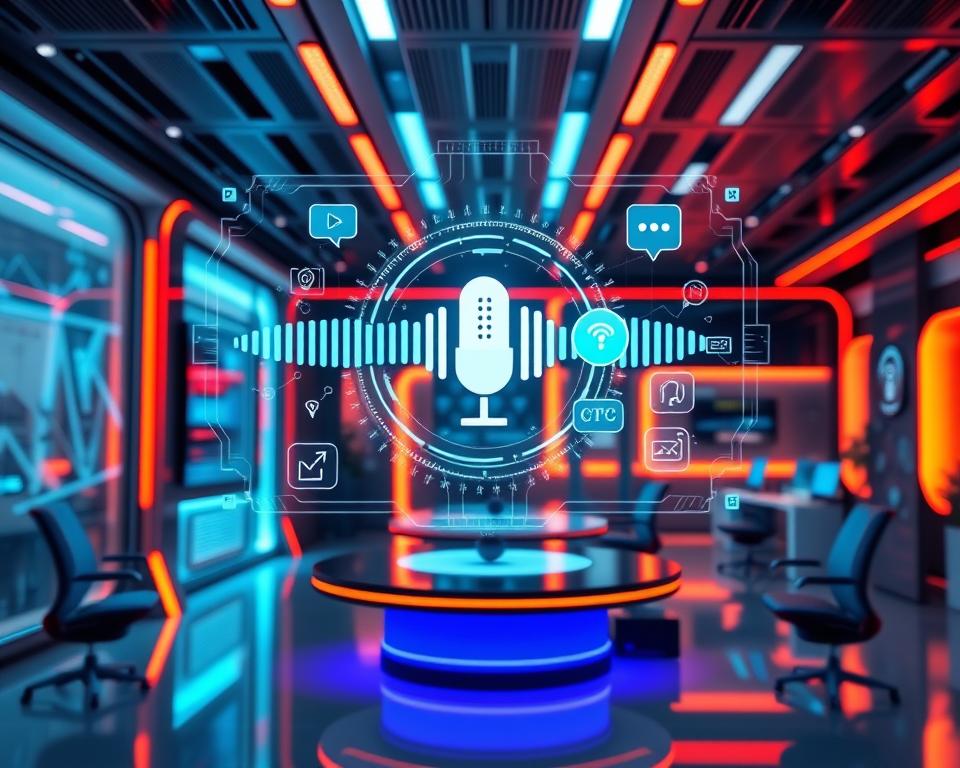
Benefits of Text to Speech for Customer Service Operations
Text to speech for customer service brings many benefits. It automates simple tasks, letting your team focus on harder ones. This makes your operations more efficient.
It also lets you personalize the customer experience. You can make the voice sound like your brand. This makes your brand feel more real and personal to your customers.
Plus, it supports many languages. This means you can help customers all over the world. It’s easy for people from different places to talk to your brand.
“Implementing Text-to-Speech (TTS) technology in contact centers can lead to a reduction in staffing costs by up to 30%.”
Using virtual assistants and voice interfaces helps with simple questions. This makes your team’s job easier. It also makes customers happier and saves you money.
Text to speech helps in many ways. It makes your operations smoother, makes customer interactions better, and lets you reach more people. Check out new tech like Murf, Lovo, Play.ht, and VoiceOverMaker. They can make your automated customer service even better.

Transforming Customer Experience with Voice Automation
Text to speech technology is changing how businesses talk to their customers. It uses speech-enabled apps and IVR systems. This way, companies can give a personal and smooth experience to their clients.
Personalization Capabilities
AI-powered text to speech looks at customer data and past talks. It gives answers that feel just right for each person. This makes customers feel connected and trusted.
Multi-language Support Features
In today’s world, talking in many languages is key. Top text to speech tools, like Murf, Lovo, and Play.ht, make talking in many languages easy. This helps businesses reach more people in a friendly way.
Voice Brand Identity Creation
Companies can use text to speech to make a special brand voice. They can adjust the voice’s tone and pitch. This makes the brand’s voice unique and helps connect with people on an emotional level.

“AI-powered voice assistants are transforming the customer service landscape, delivering personalized, multilingual, and branded experiences that delight consumers and drive operational efficiency.”
Integration of IVR Systems with Text to Speech Solutions
IVR systems and text to speech (TTS) solutions together make customer service better. IVR systems handle common questions and tasks. Adding TTS makes them even more helpful.
TTS turns text into speech that sounds like a real person. This makes customer talks more personal and fun. It makes talking to the company more enjoyable.
- IVR with TTS answers lots of questions fast. This means less waiting for customers.
- It saves money because you don’t need lots of audio files.
- It keeps the company’s voice the same everywhere. This makes the brand feel consistent.
- It works in many languages. This helps companies talk to people all over the world.
To make IVR and TTS work well, use good voices and clear text. Don’t make messages too long. This way, companies can make their customer service better and save money.
“The integration of IVR and TTS is a game-changer, making customer service smoother and more personal.”

AI-Powered Voice Response Systems for Enhanced Communication
The future of customer service is all about conversational ai and speech-enabled applications. AI-powered voice systems are changing how businesses talk to customers. They make communication better with new tech.
Machine Learning Applications
These systems use strong machine learning. It helps them get better at understanding what customers want. This means they can give answers that really fit what each customer needs.
Real-time Voice Analytics
Real-time voice analytics give insights into how customers feel. They look at speech patterns and tone. This way, the systems can respond in a way that feels right.
Adaptive Response Systems
AI-powered systems can change how they talk based on what customers say. They adjust their responses to fit what each customer wants. This makes customers feel like they’re being heard and understood.
By using conversational ai and speech-enabled applications, businesses can improve their customer service. They can give customers amazing experiences that make them stand out.

“AI-powered voice response systems are the future of customer service, bringing unparalleled personalization, efficiency, and adaptability.”
Text to Speech for Customer Service: Implementation Strategies
Adding text to speech to your customer service can change how you talk to customers. It makes customer service better, more efficient, and cheaper. But, it needs careful planning and steps to work well.
First, look at how you currently serve customers. See where you can use automated voices, like for simple questions or account info. This helps figure out where text to speech can help most.
Then, pick the best text to speech tool for your needs. Tools like Murf, Lovo, and Play.ht have great features. They support many languages, let you change voices, and track how well it works.
- Look at your current customer service and find areas to automate
- Choose the best text to speech tool for your needs
- Connect the text to speech tool with your CRM and contact center
- Teach your team about the new voice tools
- Start a small test to get feedback and make it better
Success with text to speech for customer service needs a big plan. It must think about your customers, team, and technology. By following these steps, you can make your customer service stand out.
“Using text to speech in customer service is a big change. It lets us offer personal, 24/7 help while saving money and getting better at what we do.”

Starting your text to speech for customer service journey is exciting. It’s a journey of getting better and better. Listen to what customers say, watch how it’s doing, and use that info to make it even better. This new tech can help you make your customers happy and grow your business.
Leading Text to Speech Platforms Comparison
In the world of text to speech for customer service, top names stand out. Murf, Lovo, and Play.ht lead the pack in speech synthesis and voice response systems.
Each text to speech platform has its own special features. It’s important to compare them well. Look at voice quality, language support, customization, and cost to find the best match for your business.
Murf offers over 120 AI voices in 20 languages. Lovo has 100+ language options. Play.ht has almost 600 AI voices in over 60 languages.
These platforms also vary in how well they work with other systems. They help improve customer service, make things more efficient, and save money.
By looking closely at each platform’s strengths and weaknesses, companies can choose wisely. This choice should meet their customer service needs and goals.
“The TTS market is projected to surpass $9 billion by 2030, with $3 billion in 2023, indicating its significant growth.”
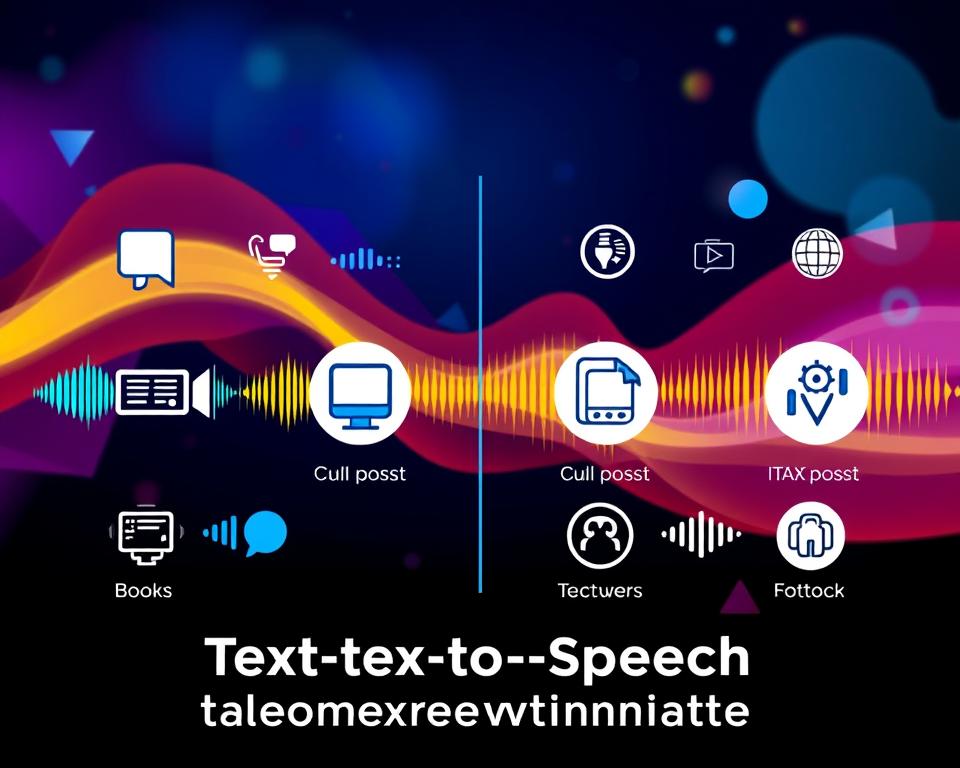
The need for voice response systems is growing fast. This means the competition among text to speech platforms will get fiercer. Keeping up with new tech is key for businesses wanting to improve their customer service.
Measuring Success: KPIs and Performance Metrics
Using text to speech for customer service needs checking its effects on your work. By watching key performance indicators (KPIs) and metrics, you learn how well your systems work. This helps see if your automated customer service is a success.
Customer Satisfaction Scores
Customer happiness is key. Scores like CSAT, NPS, and CES show how your customers feel. They help you know what to fix to meet their needs better.
Operational Efficiency Metrics
It’s also vital to see how text to speech helps your team work better. Look at times to solve issues, how many calls are fixed first, and how many hang up. These show if your team is more efficient and effective.
Cost Reduction Analysis
Seeing how much money you save is important too. Look at how much you spend less on staff and more on self-service. This shows the money you save and why it’s worth it.
Tracking these KPIs and metrics helps you see how well your text to speech works. It guides you to improve customer service, make your team work better, and save money.

“Implementing the right performance metrics is essential for understanding the true impact of text to speech for customer service solutions and ensuring they deliver the desired outcomes for your business.”
Future Trends in Voice Automation Technology
The world is moving fast towards text to speech for customer service. We’re seeing big changes. Advanced conversational AI will soon make talking to machines feel like talking to people.
We’ll see more speech-enabled applications soon. These apps will understand and answer voice commands. This means customers will get experiences that fit their likes and habits.
Biometric voice recognition is getting better too. It will make talking to machines safer and more personal. Your voice will help prove who you are and get you answers that fit you.
“The trend suggests that many workers prefer using their voices for generative AI applications like creating email responses, memos, and blog posts.”
Emotion recognition tech is also getting better. Machines will soon know how we feel by listening to us. This will change how we get help, play games, and even talk to machines.
As conversational AI and speech-enabled applications get better, talking to machines will feel more natural. The future of voice tech is bright. It promises to make our lives better and businesses more successful.

Businesses need to keep up with these changes. By doing so, they can make customers happier, work more efficiently, and stay ahead in a world that loves to talk.
Conclusion
Text to speech for customer service is changing how businesses talk to their customers. It uses advanced voice tech to make customer service better, more efficient, and cheaper. This tech adds many benefits, like personal chats, support in many languages, and easy self-service.
As this tech gets better, we’ll see even more advanced voice response systems. These will meet customers’ changing needs. Companies that use this tech will stand out, building strong customer loyalty and getting more repeat business. With spending on customer experience tech set to hit over $640 billion by 2022, now is the time to invest in text to speech.
Platforms like Murf, Lovo, Play.ht, and VoiceOverMaker are at the forefront. They offer top-notch text to speech solutions for businesses. By using these new technologies, companies can create better customer experiences. This will help them stay ahead in the changing world of customer service.
FAQ’s about Text to Speech for Customer Service
What is text to speech for customer service?
Text to speech (TTS) lets computers read digital text out loud. It sounds like a real person talking. This tech is used in customer service to read out standard info. It also helps make customer interactions more personal and supports many languages.
How does natural language processing work in TTS for customer service?
Natural language processing (NLP) is key in TTS. It makes the computer talk like a human. NLP helps the system understand what the customer wants and respond in a way that feels natural.
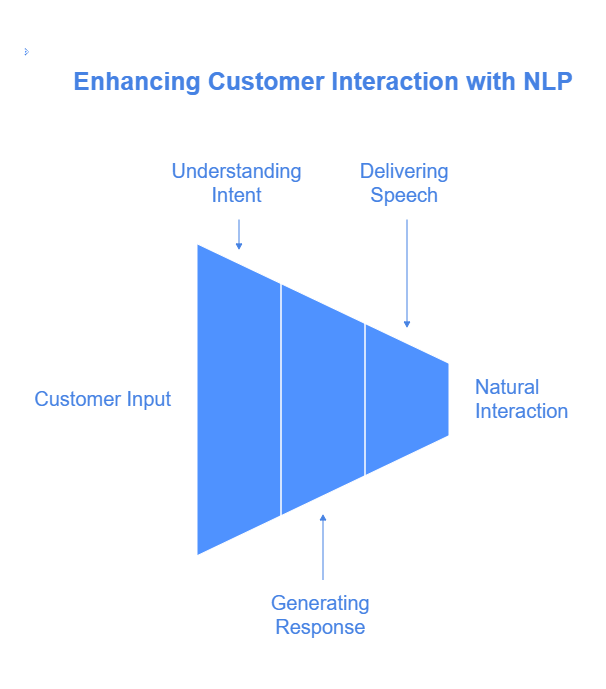
What are the benefits of integrating text to speech in customer service operations?
Using TTS in customer service has many benefits. It makes operations more efficient. It also makes customer experiences more personal. Plus, it supports many languages.
How can voice automation transform the customer experience?
Voice automation changes the customer experience in big ways. It makes interactions more personal. It supports many languages. And it creates a unique voice for the brand, leaving a lasting impression.
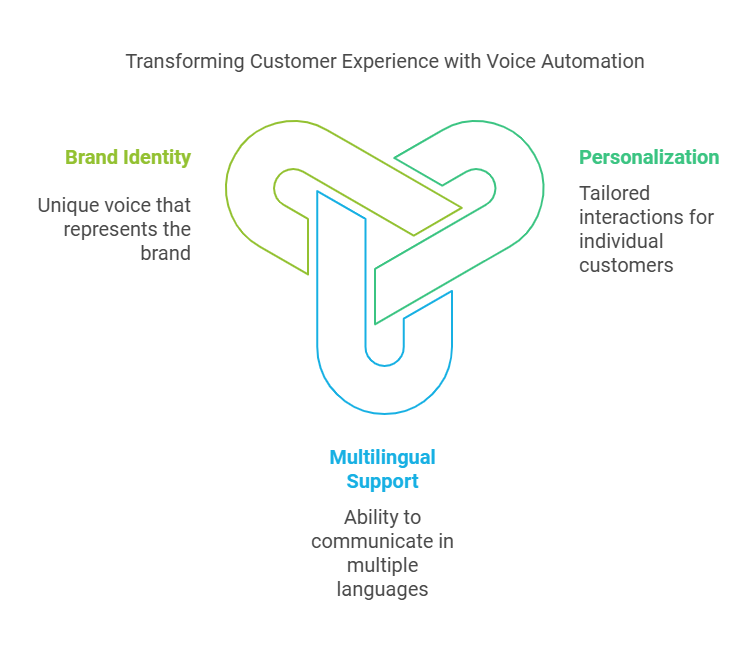
How can IVR systems be integrated with text to speech solutions?
Combining IVR systems with TTS makes customer support better. It automates tasks like surveys and call recording. It also makes interactions more personal.
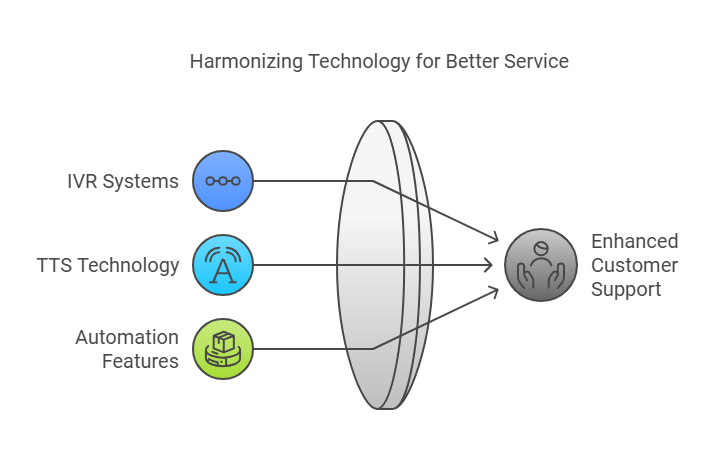
What are the key features of AI-powered voice response systems?
AI-powered voice systems use machine learning and real-time analytics. They adapt to what the customer wants. This makes interactions more relevant and personal.
What are the key strategies for implementing text to speech for customer service?
To use TTS for customer service, you need a plan. First, look at what you’re doing now. Then, find areas to automate. Choose the right TTS platform. And train your staff on the new system.
What are the leading text to speech platforms for customer service?
Top TTS platforms for customer service include Murf, Lovo, and Play.ht. Each offers unique features and voice options. They also integrate well with other systems.
How can the success of text to speech for customer service be measured?
To see if TTS is working, track important metrics. Look at customer satisfaction scores and how efficient your operations are. Also, see if you’re saving money.
What are the future trends in voice automation technology for customer service?
The future of voice tech looks exciting. We’ll see more advanced AI and machine learning. Voice responses will be more emotional. Systems will work together seamlessly. And biometric voice recognition will add security and personalization.
Source Links
- https://www.semantix.com/resources/blog/text-to-speech-software-guide
- https://www.nextiva.com/resources/learn/text-to-speech-speech-to-text
- https://justcall.io/blog/what-is-a-text-to-speech-ivr-system.html
- https://www.cogentinfo.com/resources/the-transformative-impact-of-text-to-speech-technology-across-industries
- https://voiso.com/articles/text-to-speech-future-customer-service-interview/
- https://www.linkedin.com/pulse/how-text-to-speech-tts-revolutionizing-contact-centers-customer-3y3nf
- https://elevenlabs.io/blog/text-to-speech-for-customer-service

